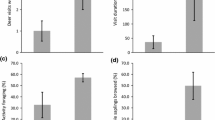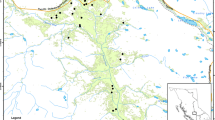Abstract.
We examined the effects of wild ungulates (deer and elk) and domestic sheep browsing on the growth, structure, and reproductive effort of two common willow species, Salix boothii and S. geyeriana, in a montane northeast Oregon riparian zone. With the use of exclosures, large herbivore effects on willows were studied in an area browsed by native mammals only and an adjacent area in which domestic sheep also lightly grazed during summer months. Growth variables were repeatedly measured on individual plants over a 5-year period to understand physiognomic and flowering responses of native willows to different levels of browsing pressure. At the beginning of the study, all willows were intensely browsed but were significantly taller in the area browsed only by native mammals than in the area also grazed by sheep (69 versus 51 cm, respectively). Willows inside exclosures responded with pronounced increases in height, crown area, and basal stem diameters while the stature of browsed plants outside exclosures stayed constant or declined. In the area browsed by both sheep and wild herbivores, the size of browsed plants remained at pre-treatment levels (<60 cm in height) for the duration of the study. There was no significant difference in growth rates of enclosed willows, indicating that current herbivory was the primary cause of growth retardation in the study area. Foliar area was strongly correlated with basal stem numbers for enclosed plants but much less so for browsed plants. Willows inside exclosures had more than twice as much foliar area per stem. Stem diameters were a positive function of crown area: stem-number ratios, suggesting lower photosynthetic potential was correlated with diminished radial growth among browsed plants. No flowering was observed until 2 years after exclusion when plants inside all exclosures and browsed willows in the wild ungulate area responded with a large pulse in flowering. Browsed plants in the sheep + wild ungulate area did not flower. The number of catkins produced per plant was significantly associated with willow height and plants <70 cm in height did not flower, thus suggesting a size threshold for reproduction in these species. Our results suggest that even relatively light levels of domestic livestock grazing, when coupled with intense wild ungulate browsing, can strongly affect plant structure and limit reproduction of riparian willows.
Similar content being viewed by others
Author information
Authors and Affiliations
Corresponding author
Additional information
Electronic Publication
Rights and permissions
About this article
Cite this article
Brookshire, J.E., Kauffman, B.J., Lytjen, D. et al. Cumulative effects of wild ungulate and livestock herbivory on riparian willows. Oecologia 132, 559–566 (2002). https://doi.org/10.1007/s00442-002-1007-4
Received:
Accepted:
Published:
Issue Date:
DOI: https://doi.org/10.1007/s00442-002-1007-4




